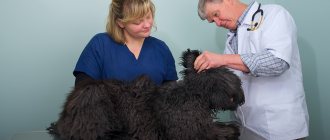Causes of itching
If your cat itches too often, sores and inflammation appear on the skin. To find out the cause of skin irritation, you should not delay a visit to the veterinarian. The most common causes of itching, besides fleas, are:
- helminthic infestation;
- scabies, ringworm, other fungal infections;
- external parasites: lice, lice, ear mites;
- insect bites (bees, wasps, bedbugs, ants);
- allergic reactions;
- ear disease;
- psychosomatic factors;
- hormonal imbalance, problems with the adrenal glands and thyroid gland;
- otitis;
- diabetes.
Allergy
Cats may suffer from allergic reactions to some of the ingredients in the food. In this case, such hypersensitivity is expressed in constant scratching of the back, muzzle, ears, and limbs.
You might be interested in: Brown dirt in a cat's ears: how to get rid of it?
To identify a food allergy, it is enough to monitor the animal’s diet and determine the food that is causing the problem.
Much more often, cats suffer from non-food allergies, which can occur due to bites from fleas or other insects.
If a cat's back or any other area of the body itches, then it is necessary to carefully check the skin for traces of insect bites: mosquitoes, wasps, bees, ants.
Another type of allergy, contact, occurs much less frequently. In this case, it is necessary to do an allergy test and determine the irritant.
Causes of infection
The most common triggers of itching are contact with other animals. Most often, such restless behavior occurs after going with the cat to the dacha, country house or nature. When in contact with a sick animal, the pet can become infected with ear mites, ringworm, scabies, and fungal diseases.
To prevent infection, before going outdoors, you need to put an anti-flea collar on your cat or apply special drops to the withers.
But even if the pet did not leave the apartment, pathogenic microbes and parasites can enter the house on the shoes and clothes of the owners, with flowers, vegetables and fruits, and other animals, for example, a dog.
A change in food, the appearance of new flowering plants in the apartment, a parasite collar, and vaccination can cause allergic reactions in your pet. It is worth keeping in mind that some breeds have an increased tendency to allergies and can even react to changing the bedding.
The appearance of new pets or unusual people in the family often causes excessive anxiety in the cat, which can be accompanied by nervous manifestations, including constant scratching and licking.
The role of veterinary diet in the treatment of itching in cats
Therapeutic nutrition works in two directions at once. On the one hand, it replenishes the pet’s need for nutrients and nutrients, and covers the need for vitamins, macro- and microelements. Your cat feels active and healthy, behaves normally, as she is not bothered by symptoms of the disease thanks to diet and treatment.
On the other hand, the veterinary diet serves as an effective support for the therapy. Forza10 diets are based on farmed meats and white fish caught from the high seas. Fish meets the need for omega 3-6-9 fatty acids, which are important for the health of the cardiovascular system and are not synthesized by the body on its own. Meat from farmed animals does not contain any pharmacological impurities that are unsafe for the health of pets and humans.
Diagnostics
If your cat is itching a lot, but there are no fleas, you should immediately look for the cause. First of all, you should visit a veterinary clinic, because there are many factors that cause such behavior in your pet, and only a specialist will make an accurate diagnosis.
- The veterinarian will definitely take a detailed history of the disease - find out the age of the cat, its lifestyle, find out when the peak of the reaction occurs and the intensity of the itching, whether anti-flea treatment and deworming were carried out, how much time has passed since the last vaccination.
- Examine areas of irritation to determine the type of skin reaction - identifying alopenia, plaques, sores, granulomas. They especially carefully check the ear canal and the space between the fingers - the most common places for allergies to manifest.
- To identify a skin disease or dermatitis, the veterinarian will conduct tests: by combing, taking scrapings from the skin for microscopic examination, an adhesive tape test (for lice, lice), examination of earwax to detect ear mites, and cytological examination of smears.
Also read the article about why a cat can scratch itself until it hurts.
Why is itching dangerous?
After determining the factors that caused the skin irritation, the veterinarian will prescribe treatment. If itching accompanies any disease and it is detected, therapy should be started immediately to prevent the development of complications and infection of the person.
- Scabies, ringworm, and fungal infections (trichophytia, dermatomycosis) not only cause deforestation and cause severe anxiety to the cat, but can also be transmitted to humans.
- Ticks, lice, lice, and other external parasites, in addition to hair loss, can lead to secondary infections.
- Food allergies, reactions to plant pollen, medications and household chemicals can lead to Quincke's edema and the death of the cat.
- If an animal loses a lot of hair and experiences skin irritation due to psychological stress, it is necessary to take urgent measures to relieve the anxiety state. Otherwise, the cat loses weight, exhaustion and dystrophy occur, and it may die.
- If itching and hair loss occur for hormonal reasons, the cat often needs lifelong therapy to function normally.
- When a cat constantly scratches its ears, the skin inside and around the ear canals becomes covered with wounds and ulcers, and suppuration begins. An ear mite or bacterial infection must be treated to relieve your pet of pain, a condition that can lead to deafness or death as a result of brain inflammation.
When a cat runs, licks, scratches and is restless beyond measure, it may well be that this is how he reacts to the bite of some insect. You should carefully examine it, find and treat the wound.
Dandruff is a common problem in cats
Despite the fact that cats are very clean animals, dandruff is quite common among them. This phenomenon may be completely natural, since animals constantly renew their skin. A small amount of dead skin flakes should not cause much concern; cats can easily cope with this problem on their own. But excessive formation of dandruff can be a signal to go to the veterinary hospital, as it indicates a pathology or disruption in the functioning of the body.
When pets get into trouble, our task is to help the purr
What is dandruff
First, let's figure out what cat skin is. It consists of 3 layers:
- epithelial is the top layer in contact with the environment;
- connective tissue dermis - the next layer in which hair follicles, skin glands, blood vessels and nerves are located;
- subcutaneous layer consisting of loose connective tissue, including fat cells.
The top layer performs a protective function and therefore requires constant updating. The keratinized particles of skin, saturated with fat, peel off from time to time in the form of scales in a small amount. These small, loose white flakes are dandruff. This is normal. But if the peeling process intensifies, the top layer ceases to perform a protective function. This should alert cat owners.
Small peeling areas of skin are normal in a healthy cat, which a clean animal can deal with on its own
Dandruff forms over the entire surface of the animal's skin, but the greatest localization is most often noticed in the back area near the tail and behind the ears. A large accumulation of dead skin flakes causes a lot of anxiety in a pet. You've probably noticed how a cat diligently and nervously begins to lick an itchy spot, sometimes trying to scratch it to feel relief. Excessive exposure can even cause wounds to form on the skin.
Excessive accumulation of dead scales on the skin is evidence of a malfunction in the cat’s body.
Signs of a problem
If you begin to notice the following signs, then your pet has a problem:
- a large accumulation of skin scales, mostly large, is noticeable on the surface of the fur;
- the cat constantly licks the problem area;
- the coat looks untidy;
- itching causes a constant desire to scratch the affected area;
- in advanced cases, hair loss and wound formation are possible.
Nervous scratching can cause wounds
Types of dandruff and places of its localization
Dandruff or, more correctly, seborrhea appears in cats regardless of age, gender or breed. Depending on the causes, dandruff can be dry or oily and accumulate in different parts of the animal’s body.
- Dry dandruff is tiny particles of epidermis that cover the cat's entire body. If you stroke your pet against the grain, the particles easily separate and swirl around like a snowball. Signs of dry seborrhea are:
- insufficient function of the sebaceous glands;
- dry skin and increased flaking;
- keratinization of the epidermis.
Dry seborrhea in a cat is the smallest particles of keratinized skin
With oily seborrhea, the hair looks very untidy
It is easiest to detect dandruff in black cats.
Veterinarian advice
To protect your pet from many unpleasant diseases, you should follow simple rules:
- Before bringing a kitten home from the street, you should check it at a veterinary clinic for the absence of fleas, worms, and external parasites, so as not to infect other cats living at home.
- After going out into nature, be sure to examine the cat to see if he has any injuries or scratches on his skin. If wounds are found, they must be disinfected.
- For cats walking on the street, as well as before going to the country, it is necessary to carry out preventive treatment against fleas, ticks and worms.
- Household chemicals, medications and other hazardous chemicals should be stored in places inaccessible to cats.
- To avoid food allergies, you should feed your cat high-quality premium or super-premium food.
- Be sure to carry out daily wet cleaning of the room in which the cat lives, using disinfectants.
- If your cat experiences excessive anxiety or unreasonable itching, contact your veterinarian immediately.
Treating scratches at home
If a cat scratches itself until it bleeds, the first step is to treat the wound so that it does not get infected. Regular human ointments are suitable for this.
To avoid further scratching of the skin, the cat should trim its claws and cover the problem area with something (for example, put a special collar or vest on the animal).
If a doctor has diagnosed lichen, the sick animal must be isolated from healthy ones. The fur next to the affected area is shaved off. The affected area is treated with ointments.
If an animal is taking any anti-inflammatory or immunosuppressive drugs, they should be stopped for a while so that the body has the strength to cope with the fungus.
The room in which the cat lives, as well as all objects with which it comes into contact, must be disinfected. Treatment of lichen can take quite a long time, but if its initial stages are detected, the animal will fully recover.
A special diet will help overcome food allergies. A product that causes a negative reaction should be excluded from the diet. You can also purchase commercial food for cats prone to allergies.
Atopic dermatitis can also cause itching. This is also an allergic reaction of the cat’s body, but it is impossible to isolate the exact allergen and completely eliminate it. Atopic dermatitis cannot be cured, but with the help of medications, all negative manifestations of allergies can be eliminated.
If a cat is suffering from a bacterial infection, the first step is to use various ointments. If an animal develops ulcers, the doctor will prescribe a course of antibiotics.
If the disease becomes chronic, the veterinarian takes microbiological tests. This is necessary to prescribe the most effective treatment for this type of bacteria.
When do you need veterinary help?
Often, scratching is almost harmless and does not cause the animal much discomfort. The owner may not even immediately notice that something is wrong with the pet. Problems begin when bacteria get into the wound. In this case, an abscess may form on the skin. In some cases, without timely treatment, the area of scratching may increase.
You might be interested in: What does a lump on a cat’s nipple indicate?
If an animal scratches a small wound once, there is no need to sound the alarm. Perhaps the cat just overdid it. The wound should be treated and the pet should be monitored.
In what cases should you take your pet to the veterinarian:
- The cat scratches the same place for a long time until it bleeds.
- The area of scratching increases.
- The wound oozes pus or does not heal.
- Scabs form on the affected area of the skin.
- The cat's hair falls out and bald patches form.
- The animal is constantly itching.
Scratching is often one of the symptoms indicating that the animal is unhealthy. In this case, you should pay attention to the general condition of the cat. You should contact your veterinarian if the following symptoms accompany itching:
- Decreased activity or excessive agitation.
- Increased body temperature.
- Lack of appetite.
- Nausea, vomiting, diarrhea.











